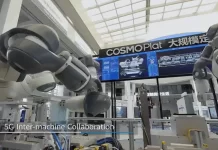
More than one million people have subscribed to a 5G mobile contract in South Korea, meaning demand for the high-speed technology has easily outpaced the country’s adoption of 4G. The need for speed isn’t just essential for rapid telecommunication — we’d all rather communicate using faster and more reliable methods.
Here John Young, APAC sales director for international industrial equipment supplier, EU Automation, discusses how manufacturing could benefit from 5G networks.

5G has created quite the media buzz in recent weeks. Although uptake continues to face its challenges, with the Australian government banning Chinese telecommunication giant Huawei’s 5G rollout in the country on national security grounds, the world is racing to implement the infrastructure.
Next generation 5G networks can be 100 times faster than 4G, making communication between devices and servers much faster. This opens up a wealth of possibilities for manufacturing, helping the industry to increase its competitiveness and boost efficiency.
The instant era
Manufacturing runs on a tight schedule. Margins are squeezed more than ever as products are increasingly varied, customized and complex. Factories need to receive and transmit a wealth of data to keep their equipment informed — and fast.
Ultra-reliable and low-latency communication (URLLC) is a new service category that will be supported in 5G, created to meet the requirements for 5G in industrial applications.
By making the most of this category, machines can receive greater roaming power. In fact, 5G has very low latency, around 10 milliseconds in comparison to the 20-30 milliseconds with 4G, so equipment can be monitored in real time by human workers. With plans to reduce this latency to as little as one millisecond, the factory floor will receive updates on machinery almost instantaneously.
Cutting the cord
According to Ericsson’s report on 5G’s potential, enhanced communication will also mean greater flexibility for manufacturing robots.
5G will handle more complex data transmissions, such as cloud robotics where the cloud’s processing is relevant for the immediate action of the robot. In combination with the cloud’s almost limitless processing and data storage, 5G communications will allow manufacturing robots to do far more than they can today. Robots will be able to exchange large amounts of information between themselves and the factory workforce, revolutionizing the shop floor along with other 5G enabled devices, such as wearables and technologies like augmented reality.
Most robots we’ve seen so far have been tethered to a wired system. This is because the wireless connectivity required for cloud computing just hasn’t been available — until now. As robots work in greater collaboration with human workers, 5G will allow them to roam free, untethered and totally wireless. Better still, instant wireless communication will speed up robot reaction times, reducing the risk of worker injury or collision with other equipment.
Real time maintenance
Maintenance is a major cost for manufacturers. Broken machines can bring production to a grinding halt, costing anything from thousands to millions of dollars in downtime. 5G-powered predictive maintenance could prevent failures before they happen.
Imagine a machine’s temperature is rising at an alarming rate. Mere seconds later, the equipment overheats and causes hundreds of thousands of dollars’ worth of damage. By the time a replacement has been ordered, delivered and installed, production is massively behind and profitability has taken a huge hit.
Now, imagine the outcome if sensors were added onto equipment for machine health monitoring. With ultra-low latency 5G, potential threats can be identified and fixed before they turn into production-stopping problems. If a piece of equipment is continuously showing signs of wear, a replacement can be ordered from a reliable equipment supplier ahead of time and without any last-minute panic.
As the Asia Pacific region, and indeed the rest of the world, gears up for the 5G era, its benefits will not be restricted to just telecommunications. As robots shed their wires, data is transmitted faster than ever and downtime is reduced with enhanced maintenance schedules, 5G will bring production to a whole new level of efficiency.
This article is by John Young, APAC Sales Director, EU Automation
Image Credit: Images Supplied


















